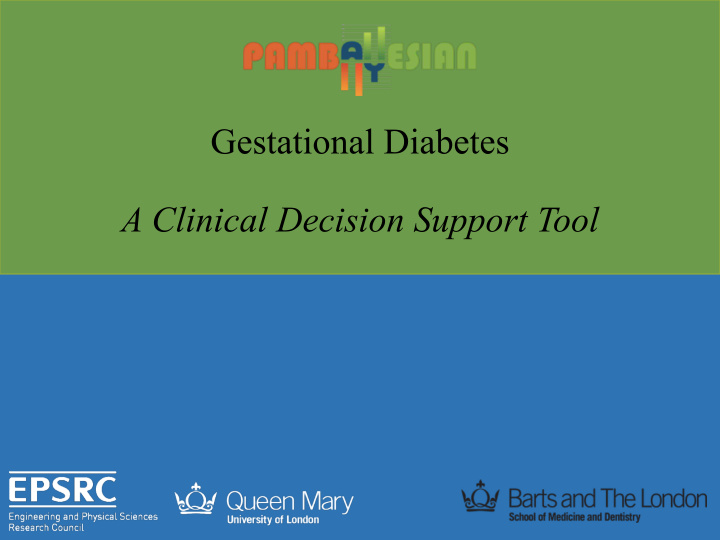



Gestational Diabetes A Clinical Decision Support Tool
Gestational Diabetes (GDM) What is it? • Glucose intolerance first diagnosed in pregnancy • NB: A small number of women will have unrecognized, pre- existing diabetes • Pregnancy hormones increase insulin resistance • Occurs in 8-24% of all pregnancies (approx1500 per year Newham and RLH)
Gestational Diabetes (GDM) Risk Factors • High BMI • Sedentary lifestyle • Family history • Previous GDM • South East Asian woman carry 6-11 times greater risk than white European woman. • 9.2% of all pregnancies account for 25.6% all GDM
GDM Complications Increased risk of: • High blood pressure and pre eclampsia • C-section or assisted delivery • Shoulder dystocia • Still birth • Hypoglycemia and jaundice for baby • Future health risks for baby associated with LGA or SGA • Future risk of T2DM for mother and baby • Up to 60% increased risk of T2DM in next 10 years
GDM Management • Multi disciplinary approach • Diet and exercise used first to achieve glycemic control • Metformin and insulin • Planned delivery of baby in timely fashion • Close observation of baby’s sugars following birth • Follow-up postnatally to ensure GDM has resolved
PAMBAYESIAN GDM Case Study Aims: • Create a new generation of easy-to-use, computerised support systems to support and empower women with gestational diabetes • Aid decision making of health professionals • Reduce pressure on busy clinical settings in primary and secondary care • Improve outcomes and experience of pregnancy care.
PAMBAYESIAN GDM Case Study
PAMBAYESIAN GDM Case Study Study Design: Retrospective Data • Literature review and review of current practice guidelines • Audit of clinical data from past GDM pregnancies (Six years from RLH) • Seek opinions of women and clinicians on their care • Gain clinician involvement • GP involvement also being sought • Build and train Clinical Decision Support Tool using Bayesian Networks
PAMBAYESIAN GDM Case Study Study Design: Prospective Data • Women with GDM pregnancy at RLH, Newham University and two community sites (~ 500 over 3 years) • Collect data alongside routine GDM care: • Booking history, blood results, routine blood glucose readings, diet, medication initiation and dose management • Decision to deliver baby • Outcomes for mother and baby • Postnatal follow-up • Present data to Clinical Decision Support Tool • Does it make the same recommendations and accurately predict risk and outcomes?
Conclusion The PAMBAYESIAN GDM Case Study will: • Give women with GDM more confidence and empowerment to self-manage and participate in care • Improve clinic experience for women and clinicians • Perhaps allow more GDM to be managed in the community, reduce pressure on secondary care
Recommend
More recommend